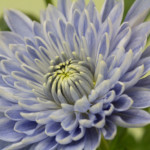 Blue flowers are rare in nature, and for good reason: the color is usually the result of mutations and quirks of acidity levels rather than an actual blue pigment. That makes genetically engineering a blue flower tricky, since you can’t just make a straightforward tweak and expect a garden full of unnatural hues. Scientists have just managed a breakthrough, though. They’ve produced the first truly blue chrysanthemum (above) by splicing in genes from two naturally blue flowers, the butterfly pea and Canterbury bell. The modifications shifted the plant’s acidity level, turning normally reddish pigments to the blue you see above. The approach is generic enough that you could theoretically apply it to other flowering plants. Blue roses, anyone? There are broader possibilities, too. While the exact techniques clearly won’t translate to other lifeforms, this might hint at what’s required to produce blue eyes or feathers. And these color changes would be useful for more than just cosmetics. Pollinating insects tend to prefer blue, so this could help spread plant life that has trouble competing in a given habitat. Just don’t count on picking up a blue bouquet. You need a permit to sell any genetically modified organism in the US, and there’s a real concern that these gene-modified flowers might spread and create havoc in local ecosystems. The research team hopes to make tweaked chrysanthemums that don’t breed, but that also means you’re unlikely to see them widely distributed even if they do move beyond the lab. Any public availability would likely hinge on a careful understanding of the flowers’ long-term impact. Via: New York Times Source: Science Advances
Blue flowers are rare in nature, and for good reason: the color is usually the result of mutations and quirks of acidity levels rather than an actual blue pigment. That makes genetically engineering a blue flower tricky, since you can’t just make a straightforward tweak and expect a garden full of unnatural hues. Scientists have just managed a breakthrough, though. They’ve produced the first truly blue chrysanthemum (above) by splicing in genes from two naturally blue flowers, the butterfly pea and Canterbury bell. The modifications shifted the plant’s acidity level, turning normally reddish pigments to the blue you see above. The approach is generic enough that you could theoretically apply it to other flowering plants. Blue roses, anyone? There are broader possibilities, too. While the exact techniques clearly won’t translate to other lifeforms, this might hint at what’s required to produce blue eyes or feathers. And these color changes would be useful for more than just cosmetics. Pollinating insects tend to prefer blue, so this could help spread plant life that has trouble competing in a given habitat. Just don’t count on picking up a blue bouquet. You need a permit to sell any genetically modified organism in the US, and there’s a real concern that these gene-modified flowers might spread and create havoc in local ecosystems. The research team hopes to make tweaked chrysanthemums that don’t breed, but that also means you’re unlikely to see them widely distributed even if they do move beyond the lab. Any public availability would likely hinge on a careful understanding of the flowers’ long-term impact. Via: New York Times Source: Science Advances
Visit link:
Genetic engineering creates an unnaturally blue flower





